
The Ford Thunderbird is a personal luxury car produced by Ford from model years 1955 until 1997 and 2002 until 2005 throughout 11 distinct generations. Introduced as a two-seat convertible, the Thunderbird was produced in a variety of body configurations. These included a four-seat hardtop coupe, four-seat convertible, five-seat convertible and hardtop, four-door pillared hardtop sedan, six-passenger hardtop coupe, and five-passenger pillared coupe, with the final generation designed again as a two-seat convertible.
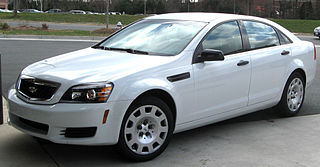
The Chevrolet Caprice is a full-sized automobile produced by Chevrolet in North America for the 1965 to 1996 model years. Full-size Chevrolet sales peaked in 1965 with over a million sold. It was the most popular American car in the sixties and early seventies, which, during its lifetime, included the Biscayne, Bel Air, and Impala.

The Honda Inspire is a mid-size sedan introduced by Honda in 1990 derived from Honda Accord chassis. The first Inspire debuted in 1990 as the Accord Inspire, a sister nameplate to the Honda Vigor, but sold at different retail channels in Japan, known as Honda Verno for the Vigor/Saber, and the Inspire at Honda Clio stores. The Inspire was developed during what was known in Japan as the Japanese asset price bubble or "bubble economy".
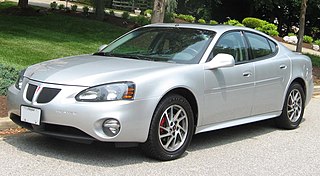
The Grand Prix is a line of automobiles produced by the Pontiac Division of General Motors from 1962 until 2002 for coupes and 1989–2008 for sedans. First introduced as part of Pontiac's full-size car offering for the 1962 model year, the model varied repeatedly in size, luxury, and performance during its production. Among the changes were positioning in the personal luxury car market segment and mid-size car offering from the second generation to the fifth generation for the sedan and from the second generation to the sixth generation from the coupe. The Grand Prix returned to a full-size car from the sixth generation to the seventh generation for the sedan, positioned below the larger Bonneville in Pontiac's model lineup.

The Jaguar XJ is a series of full-size luxury cars produced by British automobile manufacturer Jaguar Cars from 1968 to 2019. It was produced across five basic platform generations with various updated derivatives of each. From 1970 it was Jaguar's flagship four door model. The original model was the last Jaguar saloon to have had the input of Sir William Lyons, the company's founder, and the model has been featured in countless media and high-profile appearances.

The Pontiac Tempest is an automobile that was produced by Pontiac from 1960 to 1970, and again from 1987 to 1991.
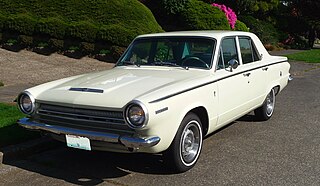
The Dodge Dart is a line of automobiles marketed by Dodge from the 1959 to 1976 model years in North America, with production extended to later years in various other markets.

The Ford Zephyr is an executive car that was manufactured by Ford of Britain from 1950 to 1972. The Zephyr and its luxury variants, the Ford Zodiac and Ford Executive, were the largest passenger cars in the British Ford range from 1950 until their replacement by the Consul and Granada models in 1972.

The Chrysler Valiant was a full-size car which was sold by Chrysler Australia between 1962 and 1981. Initially a rebadged locally assembled Plymouth Valiant from the United States, from the second generation launched in 1963, the Valiant was fully manufactured in Australia. It was sold locally but also in New Zealand and South Africa, with smaller numbers also exported to South-East Asia and the United Kingdom.
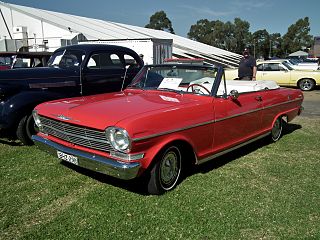
The Chevrolet Chevy II/Nova is a small automobile manufactured by Chevrolet, and produced in five generations for the 1962 through 1979, and 1985 through 1988 model years. Nova was the top model in the Chevy II lineup through 1968. The Chevy II nameplate was dropped after 1968, with Nova becoming the nameplate for all of the 1969 through 1979 models. Built on the X-body platform, the Nova was replaced by the 1980 Chevrolet Citation introduced in the spring of 1979. The Nova nameplate returned in 1985, produced through 1988 as a S-car based, NUMMI manufactured, subcompact based on the front wheel drive, Japan home-based Toyota Sprinter.

The Plymouth Fury is a model of automobile which was produced by Plymouth from 1955 to 1989. It was introduced for the 1956 model year as a sub-series of the Plymouth Belvedere, becoming a separate series one level above the contemporary Belvedere for 1959. The Fury was a full-size car from 1959 to 1961, then a mid-size car from 1962 to 1964, again a full-size car from 1965 to 1974, and again a mid-size car from 1975 to 1978. From 1975 to 1977 the Fury was sold alongside the full-size Plymouth Gran Fury. In 1978, the B-body Fury was the largest Plymouth, and by 1979, there was no large Plymouth. This was rectified in 1980 with the R-body Gran Fury, followed by the M-body Fury in 1982. Production of the last V8, RWD Plymouth Fury ended at Kenosha, WI, on December 23, 1988. Unlike its sibling brand, Dodge, Plymouth would not live to see the resurgence of the large, V8/RWD sedan. The nameplate "fury" is from Latin for "rage, extreme anger, strength or violence in action"

Plymouth Belvedere is a series of American automobile models made by Plymouth from 1954 to 1970. The Belvedere name was first used for a new hardtop body style in the Plymouth Cranbrook line for the 1951 model year. In 1954 the Belvedere replaced the Cranbrook as the top trim and became a full model line with sedans, station wagons and convertible body styles. The Belvedere continued as Plymouth's full-sized car until 1965, when it became an intermediate, and was replaced after the 1970 model year by the Satellite, a name originally used for the top-trim level Belvederes. The nameplate "belvedere" is Italian for "beautiful sight" or “fair view”. Chrysler also had the Belvidere Assembly Plant in Belvidere, Illinois which began production in 1965.

The Toyota Mark II is a compact, later mid-size sedan manufactured and marketed in Japan by Toyota between 1968 and 2004. Prior to 1972, the model was marketed as the Toyota Corona Mark II. In some export markets, Toyota marketed the vehicle as the Toyota Cressida between 1976 and 1992 across four generations. Toyota replaced the rear-wheel-drive Cressida in North America with the front-wheel-drive Avalon. Every Mark II and Cressida was manufactured at the Motomachi plant at Toyota, Aichi, Japan from September 1968 to October 1993, and later at Toyota Motor Kyushu's Miyata plant from December 1992 to October 2000, with some models also assembled in Jakarta, Indonesia as the Cressida.

The Humber Super Snipe is a car which was produced from 1938 to 1967 by British-based Humber Limited.
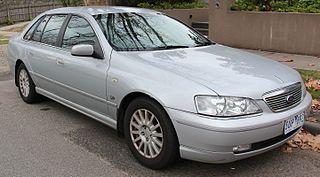
The Ford Fairlane and LTD are full-sized luxury vehicles produced in a series of models by Ford Australia between 1959 and 2007.

The Jaguar Mark 2 is a mid-sized luxury sports saloon built from late 1959 to 1967 by Jaguar in Coventry, England. The previous Jaguar 2.4 Litre and 3.4 Litre models made between 1955 and 1959 are identified as Mark 1 Jaguars.

The Bristol 407 was a sports tourer car produced by British manufacturer Bristol Cars between 1961 and 1963. It was the first Bristol model to be made by the company after separation from the Bristol Aeroplane Company, which had built all previous Bristol models. Outwardly it resembled the 406, on which it was based, and which had been produced between 1958 and 1961.

The Bristol 409 was the third series of cars from British manufacturer Bristol Cars powered by Chrysler V8 engines. It was actually introduced before the older Bristol 408 went out of production and only gradually supplanted that model after a year.

The Peugeot 408 is a small family car produced by Peugeot. It was unveiled on January 25, 2010, at the Beijing Auto Show and sales began in China on April 8, 2010. In November 2010, production of the 408 commenced in El Palomar, Buenos Aires, Argentina, with sales starting in April 2011.

The third-generation Mustang was produced by Ford from 1978 until 1993. Being built on Ford’s Fox platform, it is commonly referred to as the Fox body Mustang. It evolved through several sub-models, trim levels, and drivetrain combinations during its production life. It underwent updates for 1987, and for a time seemed destined for replacement with a front-wheel drive Mazda platform. However, company executives were swayed by consumer opinion and the rear-wheel drive Mustang stayed, while the front-wheel drive version was renamed the Ford Probe. Enthusiasts group the generation into two segments: the 1979–1986 cars, with their quad headlight arrangement, and the 1987–1993 cars, with their aerodynamic composite headlamps and front fascia styling. Production ended with the introduction of the fourth-generation Mustang (SN-95) for the 1994 model year.




















